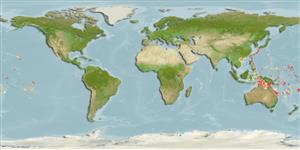Classification / Names
Common names | Synonyms | Catalog of Fishes(genus, species) | ITIS | CoL | WoRMS | Cloffa
Teleostei (teleosts) >
Ovalentaria/misc (Various families in series Ovalentaria) >
Pomacentridae (Damselfishes) > Pomacentrinae
Etymology: Pomacentrus: Greek, poma, -atos = cover, operculum + Greek, kentron = sting (Ref. 45335); bipunctatus: Named Pomacentrus bipunctatus as reference to pair of dark spots on the upper operculum and upper pectoral fin base which is its most distinctive marking and a feature lacking in other pomacentrids from the Marshall and eastern Caroline Islands.
More on authors: Allen & Randall.
Environment: milieu / climate zone / depth range / distribution range
Ecology
Marine; reef-associated; non-migratory; depth range 5 - 43 m (Ref. 54758). Tropical
Central Pacific: Known from the Marshall Islands at Enewetak and Kwajalein atolls, and also from Truk in the eastern Caroline Islands.
Size / Weight / Age
Maturity: Lm ? range ? - ? cm
Max length : 5.5 cm SL male/unsexed; (Ref. 54758)
This species occurs in lagoonal habitats on coral reef substrates, often on pinnacle or patch reefs at depths between 5 and 43 m (Ref. 54758). Life history characteristics for the family specify that this group is oviparous, with distinct pairing during breeding (Ref. 205). Eggs are demersal and adhere to the substrate (Ref. 205). Males guard and aerate the eggs (Ref. 205).
Life cycle and mating behavior
Maturity | Reproduction | Spawning | Eggs | Fecundity | Larvae
Life history characteristics for the family specify that this group is oviparous, with distinct pairing during breeding (Ref. 205). Eggs are demersal and adhere to the substrate (Ref. 205). Males guard and aerate the eggs (Ref. 205).
Allen, G.R. and J.E. Randall, 2004. Two new species of damselfishes (Pomacentridae) from Micronesia. aqua, J. Ichthyol. Aquat. Biol. 9(2):75-87. (Ref. 54758)
IUCN Red List Status (Ref. 130435: Version 2025-1)
Threat to humans
Harmless
Human uses
Tools
Special reports
Download XML
Internet sources
Estimates based on models
Preferred temperature (Ref.
123201): 28.3 - 29.1, mean 28.5 °C (based on 12 cells).
Phylogenetic diversity index (Ref.
82804): PD
50 = 0.5000 [Uniqueness, from 0.5 = low to 2.0 = high].
Bayesian length-weight: a=0.02455 (0.01155 - 0.05216), b=2.98 (2.81 - 3.15), in cm total length, based on LWR estimates for this Genus-body shape (Ref.
93245).
Trophic level (Ref.
69278): 2.7 ±0.3 se; based on size and trophs of closest relatives
Resilience (Ref.
120179): High, minimum population doubling time less than 15 months (Preliminary K or Fecundity.).
Fishing Vulnerability (Ref.
59153): Low vulnerability (10 of 100).
🛈
